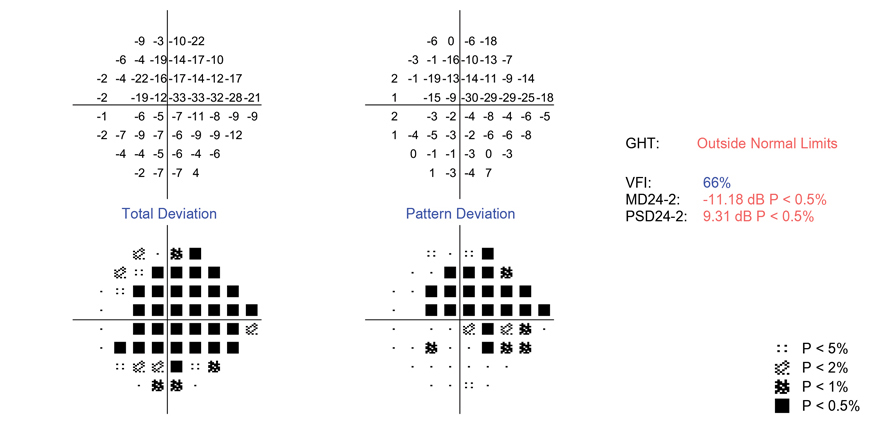 |
| POAG patients with dementia were 34% less likely to have a visual field test than those without, but this could be because cognitive demands needed for the test make it difficult to administer or unreliable in these patients. Photo: Danica Marrelli, OD. Click image to enlarge. |
Older adults who deal with neurological disease, especially various types of dementia, are a vulnerable population. To survey how dealing with neurodegeneration might bleed into eye care, researchers from the University of Pennsylvania recently looked at patients with primary open-angle glaucoma (POAG) and neovascular age-related macular degeneration (nAMD)—both conditions common among those with dementia. Their work was published in Graefe's Archive for Clinical and Experimental Ophthalmology.
Over 45,000 older adults from the US were reviewed using the Clinformatics Data Mart Database spanning the years 2000 to 2022. From this, two cohorts were created for newly diagnosed POAG and nAMD patients; within each cohort, an exposure group was created of newly diagnosed dementia patients.
The primary outcome was number of eyecare provider visits. On this point, POAG patients with dementia demonstrated lower rates of eyecare visits, as did nAMD patients with dementia. Secondary analyses for those with glaucoma included number of visual field tests, OCT and glaucoma medication prescription coverage. Similarly, POAG patients in this respect also saw declined rates of testing use for visual fields, OCT and lower rates of medication coverage. Secondary analysis for wet AMD patients included number of injections performed, and here, too, such patients with comorbid dementia received fewer intravitreal injections than those without dementia.
Upon further discussion, the study authors specify that rate of reduction in care was fairly consistent across both eye conditions, on average, with dementia patients experiencing around 75% the number of visits as non-dementia patients. Similarly reduced across both diseases was in-office testing and treatment, with dementia patients receiving around two-thirds the testing and injections that those without dementia received. Prescription drug coverage was reduced by dementia patients receiving 17% less coverage; however, this lower rate compared with other factors may be because obtaining prescriptions is easier to obtain without needing to be seen in office.
In their paper on the research, the authors elaborate on possible reasons for why dementia patients were seen less by eyecare providers; these include difficulty making, remembering and arranging transportation to appointments, especially if support from caregivers is limited. Also, a potential contributor is the fact that continuity of outpatient ophthalmic care may be limited with hospitalizations or other comorbidities.
Related to this, the authors wrote that “visual impairment is an important determinant of quality of life and is associated with progression and neuropsychiatric complications of dementia, so it is possible that promoting eye care utilization in this population may improve functional outcomes.”
Looking to apply their findings to clinical applications, the investigators convey that “future studies should examine whether eye care underutilization is associated with worse visual, cognitive and functional outcomes in people living with dementia. If this is the case, then efforts to promote access to eye care may have a positive public health impact in this population.”
Hamedani AG, Chang AY, Chen Y, VanderBeek BL. Disparities in glaucoma and macular degeneration healthcare utilization among persons living with dementia in the United States. Graefes Arch Clin Exp Ophthalmol. July 12, 2024. [Epub ahead of print]. |


